Getting Results: Pots, Politics, and the Pueblo Revolt
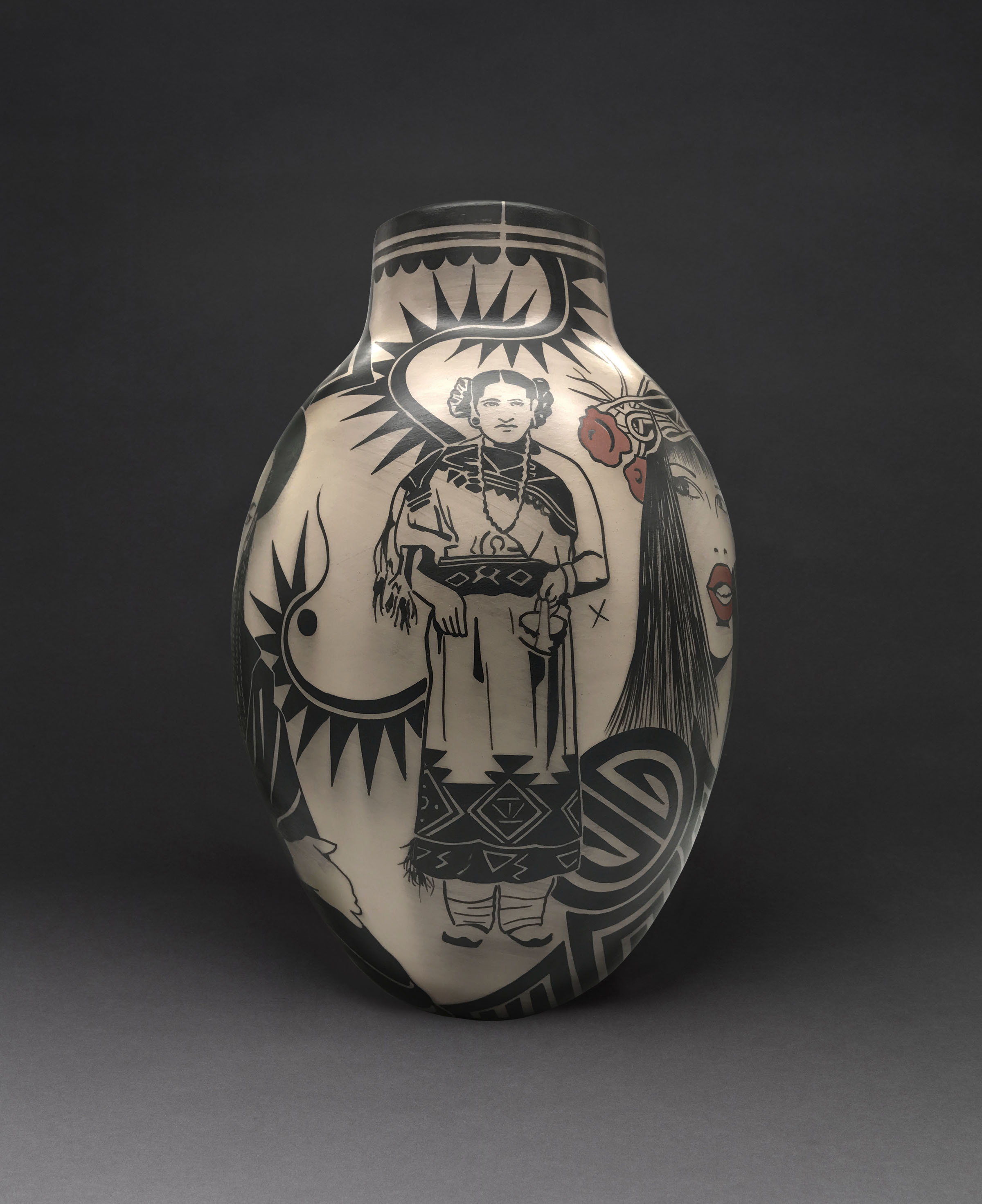 Virgil Ortiz got his start in clay making pots at his home on the Cochiti Pueblo in New Mexico. He follows and extends the matrilineal heritage of Pueblo pottery. Laurencita Herrera, his grandmother, and Seferina Ortiz, his mother, were both renowned Pueblo potters. Tish Agoyo is his cousin. She is also his manager and the founder of NDN Star, a company she started to support and promote indigenous artists. The relationship between Ortiz and Agoyo provides a unique opportunity to view a studio practice from two distinct angles that can be at odds with each other, especially when embodied by one person. Their partnership is an example of two people working toward a common goal, each playing to their strengths. Agoyo, generously transparent, sat down with Studio Potter last month to share her insights about the business of art, the rewards (and hazards) of letting your authentic voice shine, the need to be honest and disciplined in order to find freedom, and the importance of a strong foundation. Yes, Ortiz is operating in a higher economic bracket than most functional potters, but the conversation with Agoyo raises points that are worth considering in any market.
Virgil Ortiz got his start in clay making pots at his home on the Cochiti Pueblo in New Mexico. He follows and extends the matrilineal heritage of Pueblo pottery. Laurencita Herrera, his grandmother, and Seferina Ortiz, his mother, were both renowned Pueblo potters. Tish Agoyo is his cousin. She is also his manager and the founder of NDN Star, a company she started to support and promote indigenous artists. The relationship between Ortiz and Agoyo provides a unique opportunity to view a studio practice from two distinct angles that can be at odds with each other, especially when embodied by one person. Their partnership is an example of two people working toward a common goal, each playing to their strengths. Agoyo, generously transparent, sat down with Studio Potter last month to share her insights about the business of art, the rewards (and hazards) of letting your authentic voice shine, the need to be honest and disciplined in order to find freedom, and the importance of a strong foundation. Yes, Ortiz is operating in a higher economic bracket than most functional potters, but the conversation with Agoyo raises points that are worth considering in any market.
Studio Potter: Hi Tish, it’s good to see you. Thank you for agreeing to chat today and share your experience, how have things been going for you?
Tish Agoyo: We're busy and so grateful. The last year seems like a complete blur – we have not stopped.
SP: Do you think that is because people were working to support the arts more in 2020, or because people needed the arts more in 2020?
TA: I think it’s a combination of things. All the folks that were staying home, the power of social media, and the younger demographic jumping on Instagram, paying attention to what's going on and connecting with a lot of artists. I’ve watched Virgil’s social media stats soar. People are interested in what he’s doing. That interest can, in part, be attributed to the fact that a lot of museums and institutions are switching up the way they do business, using zoom as a new platform to communicate with their audiences. It has resulted in speaking opportunities and engagements for Virgil, even some acquisitions. We're about to conclude another acquisition shortly. It's touching that it's happening like this for him. We've just been in a wave of opportunities right now.
SP: Virgil already had an impressive portfolio, in multiple mediums, and a significant amount of recognition before 2020. His work has been exhibited in prestigious museums and he has collaborated with high profile designers and artists. Acknowledging that he already had a certain level of visibility, do you think the national push for better representation of BIPOC artists had anything to do with the increased opportunities? Do you think institutions saw Virgil as an obvious choice?
TA: I don’t believe so. You know, folks were paying more attention to those things. What did happen for us was that Virgil and I had a little bit of a tug of war [this year], because I didn't want to become a political voice. Virgil was reacting. Virgil was definitely paying attention. You know, there I was – I've always been the one saying, “We can't really get involved with this. We can't take that risk.” You can lose followers. You can lose clients. You can lose collectors – the people that are your bread and butter. We struggled with that this year. On a recent phone call – not recent, it's been a few months – Virgil said, “I am not going to be silenced,” and I said, “Okay,” but I think there's a way to communicate your point of view. I think language is key in how you phrase things. I said, “I'm good. I'll support you, but let's just be mindful of how we phrase our support or maybe our dislike to something that's happened.” It does affect business. People can boycott you in a hot second, and then you're done. So we have to be mindful – every effort was made to be mindful about that. But there is no secret about how Virgil feels.
He made his Trump pot, the Rise Up pot. It is a perfect example of Virgil expressing his political views. He made that in 2016, right when the new administration was coming on board. It was crazy.
The vessel in question features the former president. Ortiz calls it one of his prediction pots, “I completed it in December 2016. If you recall, the Dakota Access Pipeline protest was in full form. If you view all angles of the vessel, it tells a story of heartbreak, turbulence, and corruption that will eventually eat away at politicians from the inside out. This piece speaks volumes for all to rise up and empower ourselves for the greater good.”[1]
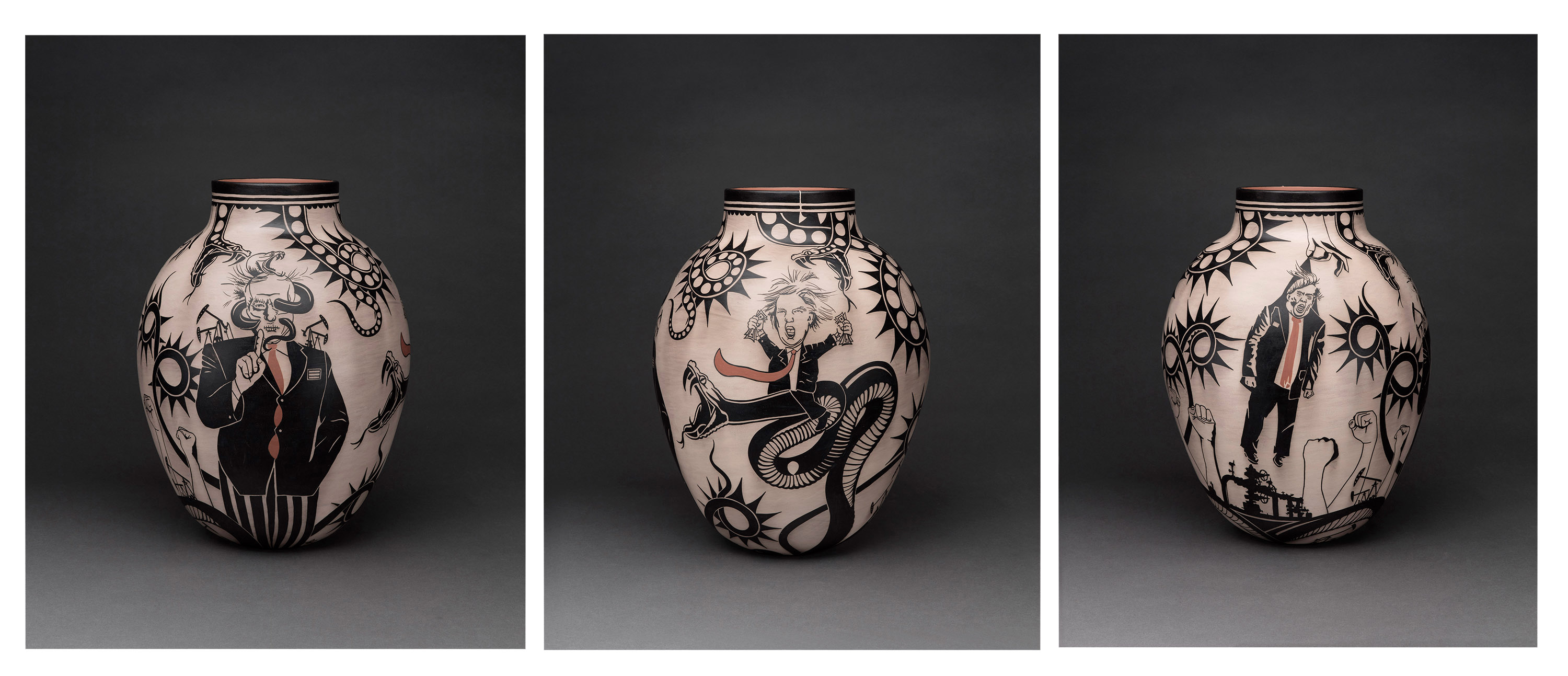
We got pushback when we first unveiled it. There were specific people that just completely stopped communication. It was obvious why. It was eventually acquired by a couple from Colorado. They reached out to us and said, “Hey!” Of course, my job is to vet everybody. I've got to chat with people before the invitation is made for them to come over to Virgil’s studio. It’s kind of the big deal for a collector to get a studio visit with Virgil. We just don't – you’ve got to know who you're allowing to go there. So I set up the meeting with the couple and V [Tish’s short-hand for Virgil]. They were so astonished by his story and the description of the designs around the pot. They said, “We've got to have this.” Rise Up found a new home that day.
When I think back, I felt we should be careful. He did get some pushback. I could feel it was bothering him, but then he came out of this space that he was in, and he said, “No, I'm not going to be silenced. I'm an artist, and I'm allowed to create. If folks don't appreciate or agree with what I'm saying, it's okay. We just keep it moving.” Once I adapted to his attitude, we're cool. I just had to say, “Okay. You know, you're right.” If we're gonna work in unison, hand-in-hand, I have to be able to go, “Okay,” and just yield – have some faith. What's the worst thing that can happen? It's not like we're awful people trying to send a horrible message. We're talking about truthful things – real things – that have happened to indigenous folks. And other folks.
SP: Artists have been recording and responding to history throughout time.
TA: Yes, we just have to navigate carefully and tactfully. You know, when you listen to Virgil describe his art, he's quite funny. He doesn't get on his high horse and he’s a great storyteller.
SP: Tish, this is a great opener to start to understand the depth of your relationship with Virgil, but will you share your own background in business and in the arts? How did you came to work with Virgil in a professional capacity?
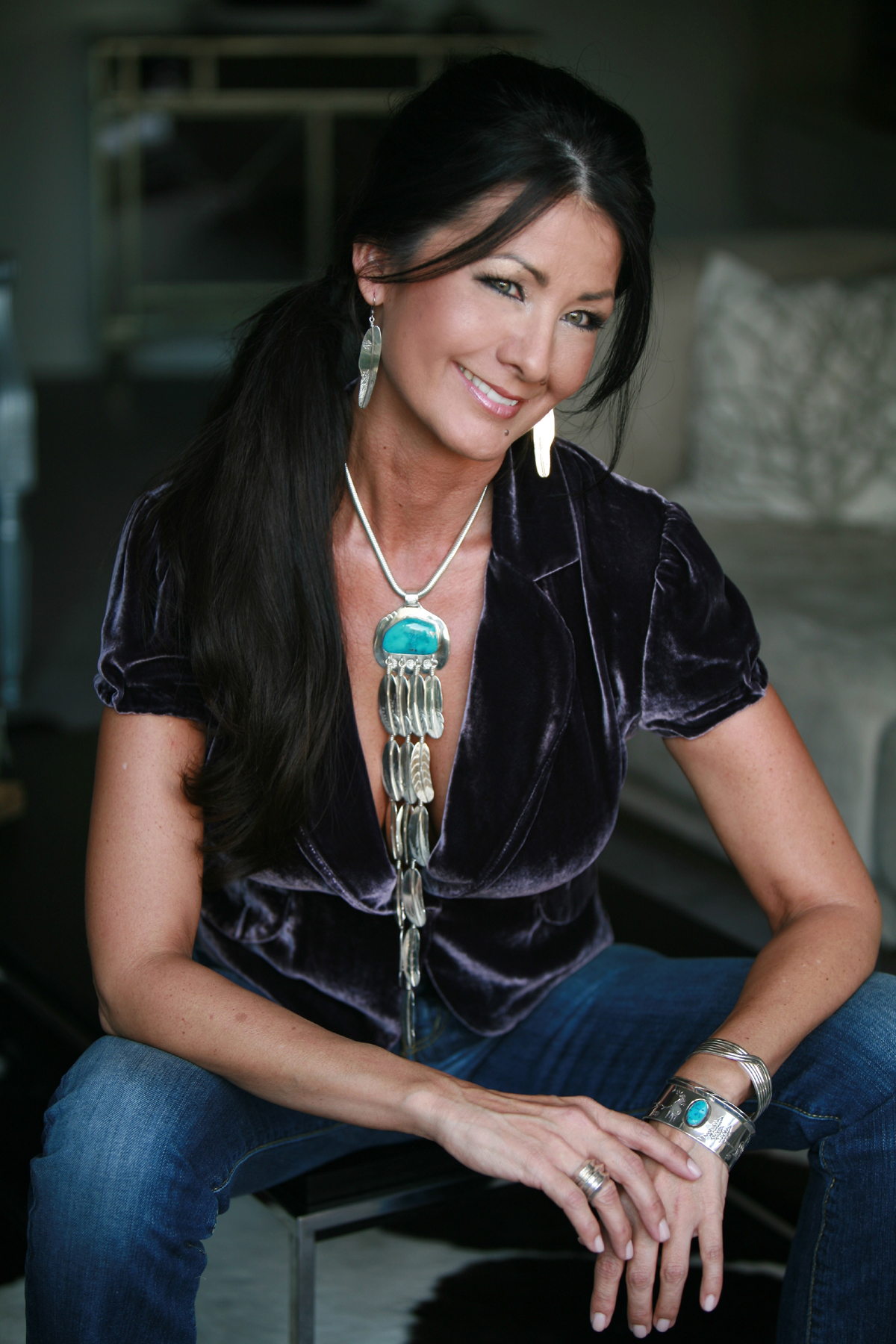 TA: Sure. I'm from Cochiti Pueblo. My mother's from Cochiti Pueblo. My father is from Ohkay Owingeh, which is up in northern New Mexico. As soon as I graduated from high school, I was like, I'm out of here. I had no interest in going to college. I just wanted out – off the res, and I wanted to go somewhere. I wanted to go to a city. I hitched a ride with my high school classmate and I headed up to Denver, Colorado. My first job was as a restaurant hostess for one of the most popular restaurants in downtown Denver called Marlowe’s. I did that gig until I turned twenty-one. I became their bookkeeper and did that for several years – there’s my accounting background. Then, I want to say in the late eighties, I moved to LA, my first job in Los Angeles was for a German-owned tour company. I started off answering the phone calls. They were so impressed with my skills that I went up to sales. Then I kicked ass in sales and got into product development. Then I became their computer geek until they went under in the late nineties. Next I got a phone call out of the blue to come work for a Mexican-owned airline. I’d never been to Mexico. I got on the plane. I went to La Paz and Baja, Mexico, met with the owner, got back to Los Angeles, walked into my apartment that day, the phone rang, and they said, “The job is yours.” Eventually I got into management within the travel industry, but it's always been sales and marketing for me.
TA: Sure. I'm from Cochiti Pueblo. My mother's from Cochiti Pueblo. My father is from Ohkay Owingeh, which is up in northern New Mexico. As soon as I graduated from high school, I was like, I'm out of here. I had no interest in going to college. I just wanted out – off the res, and I wanted to go somewhere. I wanted to go to a city. I hitched a ride with my high school classmate and I headed up to Denver, Colorado. My first job was as a restaurant hostess for one of the most popular restaurants in downtown Denver called Marlowe’s. I did that gig until I turned twenty-one. I became their bookkeeper and did that for several years – there’s my accounting background. Then, I want to say in the late eighties, I moved to LA, my first job in Los Angeles was for a German-owned tour company. I started off answering the phone calls. They were so impressed with my skills that I went up to sales. Then I kicked ass in sales and got into product development. Then I became their computer geek until they went under in the late nineties. Next I got a phone call out of the blue to come work for a Mexican-owned airline. I’d never been to Mexico. I got on the plane. I went to La Paz and Baja, Mexico, met with the owner, got back to Los Angeles, walked into my apartment that day, the phone rang, and they said, “The job is yours.” Eventually I got into management within the travel industry, but it's always been sales and marketing for me.
My last business trip was to Italy and I was negotiating rates with hotels and airlines, etc. I was on my way back home – this is 2003 or 2004 – I can’t remember exactly. I came back to New York. And that's when V had just done his collaboration with Donna Karan.[2] Since I just
happened to be in town, I went to her flagship store. I could not believe what I was looking at. He had those mannequins in the windows with pottery heads on them. I looked at the whole collection and I was like, WHAT? WHOA! WHAT? Oh my god, this is insane.
We said goodbye. Then months later, V pops up in Los Angeles and we met at a hotel. He showed me this handbag he had sewn and hand-painted. He said to me, “Can you help me make this?” I said, “Sure.” I don't know how I did it except that I already had relationships within industry.
SP: When he said, “make this,” he meant, “manufacture it?”
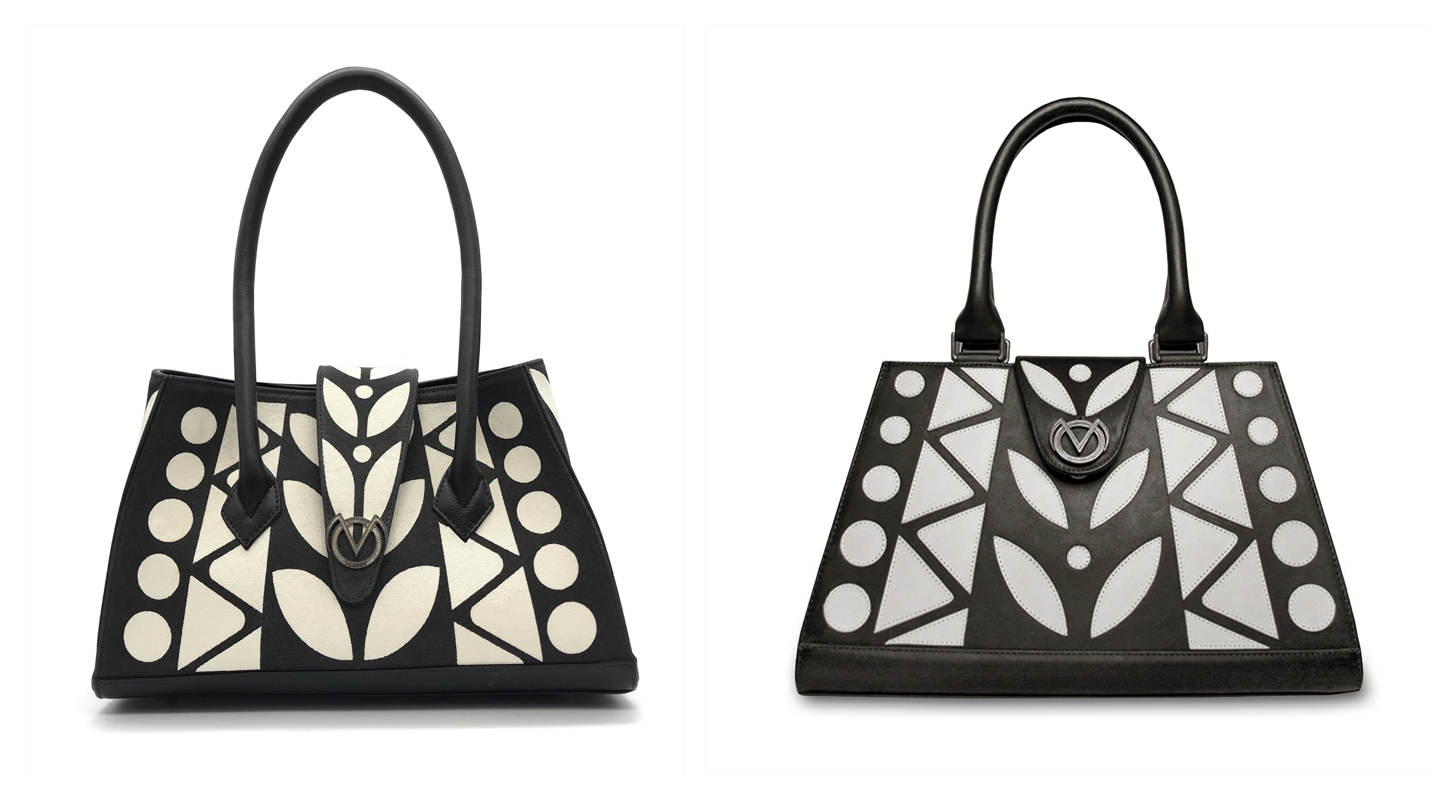
TA: Yes manufacturing. I thought, “Okay, how am I going to do this?” I went to an individual that I knew who could probably finance the project. And he did. This is how we created Virgil's first line of handbags. It was a limited edition there were only one hundred made. They sold out – quickly.
Then I stopped working with the travel company and I created NDN Star. The idea was that, because I came from New Mexico and I had relationships with these native artists, I would represent them and help bring their craft into the mainstream. That's how NDN Star was born. I set up shop and became this talent management agency. At least that was the idea. But because Virgil has so much going on, I wouldn't be able to give another artist the attention they deserve. Managing VO Creations [Ortiz’s brand] is a twenty-four-seven gig.
After the purse we went through the formalities of contracts. We set up how our business relationship would work and we just got to business – like immediately. I would manage his career. He would create. It was my job to see where we could go, knowing that I had no manufacturing background, knowing that I had no retail experience – none of that. But it all just came to us easily because of the relationships we each had built up to that point. That's the story of how we came together. Now I handle all facets of his career: his talent, his mediums, museum exhibitions, galleries [Ortiz is exclusively represented by King Galleries in Scottsdale, Arizona and Santa Fe, New Mexico] – everything that he does.
SP: Most artists embody the creative role and the business role within themselves – to varying degrees of success. Between you and Virgil, it's a unique opportunity to see these two roles executed separately. Can you get more specific about how the flow of conversation and decision making goes between the two of you and how do you support his creative output and how do you protect his interests?
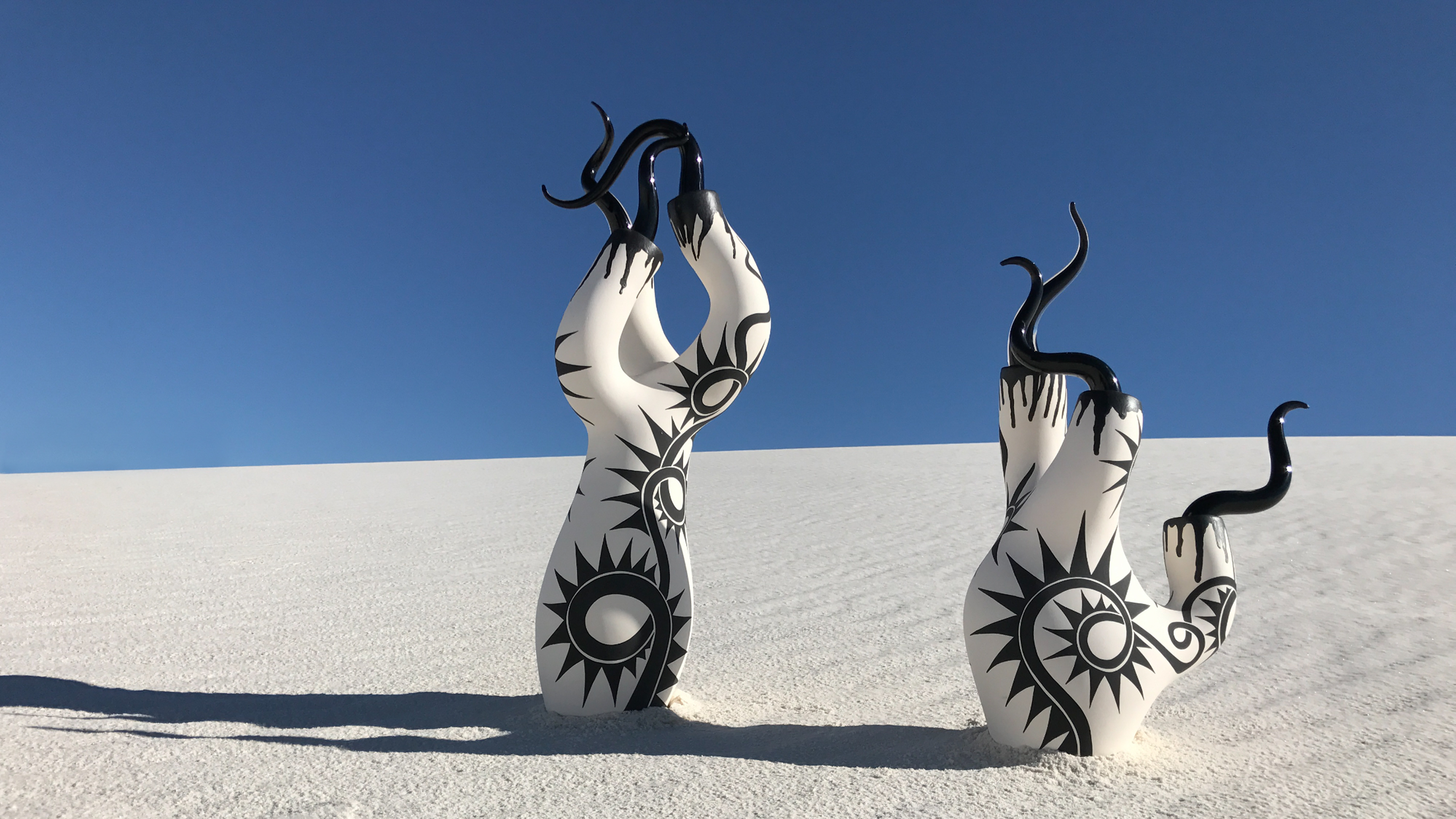
TA: Sure, you know, a perfect example to use is Indian Market.[3] We'll start having conversations a year prior. “Hey Tish, this is what I'm thinking.” And, you know, some of it, I'm like, “Okay, Okay, I could see that, okay.” It's just constant talking and building because he's got to, number one, create the work, right? And then we’ve got to fit in all of the other moving parts. There’s a theme and we have to think about how we're going to cover expenses and market it. We have to think about the press component. Virgil doesn't just make his pottery for a show. It's the clothing. It's the jewelry. It’s everything – a full experience. He gives me his vision. Then we sleep on it and see where we land.
I would say within a month's time, we know what we're doing. Then we organize it. We issue timelines – deadlines – for all the things we need in order for this to be a success. Virgil does not want to see paper. He doesn't want to type. He doesn't want to look at numbers. He doesn't do budgeting. He wants nothing to do with it. And he shouldn't want to have anything to do with that. His job is to create. My job is to say, “It's going to cost us this much to do this, so how are we going to make this work?,” or, “I'm sorry V, I hate to say this to you, but we're not going to be able to do this, because it costs this much.” Those are the conversations that I have to have because I'm doing all the research. I'm packaging everything for him to see. That's how our relationship works. You know, some things we can't do – some things we can do. And then we're always amazed after Indian Market – how do we pull that off? It just seems so grand to people when they come in and look at what we've got set up. It's a lot of hard work but we find a way. I mean, I'm the one writing checks and thank you notes, making sure everyone feels appreciated for their hard work and effort. And that's what we've done. Afterwards we're so exhausted, like, “Wow, we really did that. How did we do that?” Because it's him and I.
SP: When you’re creating budgets, is it always project-to-project or is there an annual budget?
TA: Always project based.
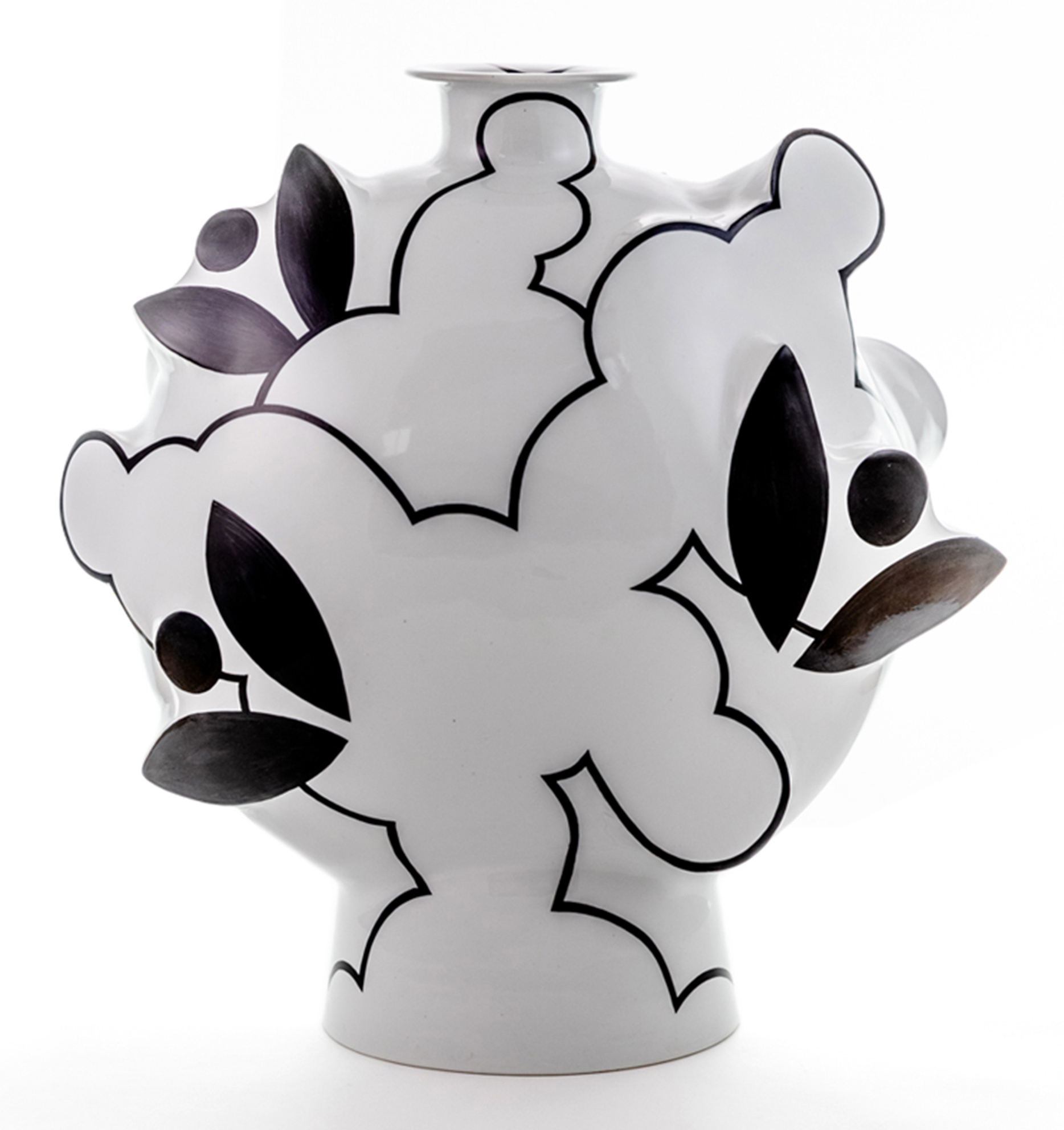 SP: Right now, I’m thinking that I bet everyone wished they had a Tish in their corner.
SP: Right now, I’m thinking that I bet everyone wished they had a Tish in their corner.
TA: You know, I wish artists could have a Tish, because I can tell you – we're doing a collaboration with an artist right now… He was completely overwhelmed by, or couldn't believe, how we do business. Artists don't have an individual like me, but they need somebody like me because they have to create and it’s so overwhelming to have to think about all the other things. They can't focus on their creations, because they're worried about, “Oh, how am I going to do this?” The business end of things takes time. It takes people who know what they're doing. V and I have gone through all of those learning lessons. Because we've been doing it for so long, we know what to do. It takes years of experience to get to the place where we're at now and we're still learning as we go. Technology is changing. The ways of marketing are changing. We have to keep up with it all, but we embrace it. It's fun. We make it fun.
SP: So right now, in this moment, everyone who reads this does get to have a Tish. What would you advise? You know, this dialogue started because an artist was changing from solely marketing on Instagram to working with galleries and was finding some difficulties in that transition. What key points would you say artists need to look out for on the business end of things?
TA: When it comes to galleries? Vet! Vet! Vet! Do your homework. Some of these artists get so overwhelmed with some of the language [used in business and in contracts], because they're not used to that language. My advice is, find a family member, find a mentor, find somebody you can ask, “Hey, can you take a look at this contract? Can you give me your opinion? Is there anything that sticks out to you that I should address?” It can be intimidating to talk about money and so artists may feel like they have to settle for the terms. For this reason I am for short terms. I'm a short term contract gal, because that way you get to see what the gallery is doing on your behalf. Is it working? Is it not working? You know, what can you do to check in with the gallery? Follow up with them and ask, “Hey, what's going on?” Sometimes artists’ works sit in galleries and collect dust. That does nothing for the artist. They get forgotten.
I think the critical part is locating and finding a gallery that you have real good synergy with, that shares the same beliefs as you do and that believes in your art. You know, some galleries just want to have art to fill up the space in their gallery.
SP: What steps do you take when you are vetting potential business partners, collaborators, or clients?
TA: Thank God for Google, right? I will make phone calls and I'll take a moment to think like, “Okay, what attorney do I know?” I've just maintained relationships over the years. I have access to attorneys that are our friends. I can say, “Look, this is what's happening, what do you know about this?” Most vetting is just research – a lot of just picking up the phone. Although sometimes, you could well just ask the person point blank, “It's come to my attention that, this and this, then this – how do you respond to that?” When you can have a direct conversation with people, you'd be amazed at what you get.
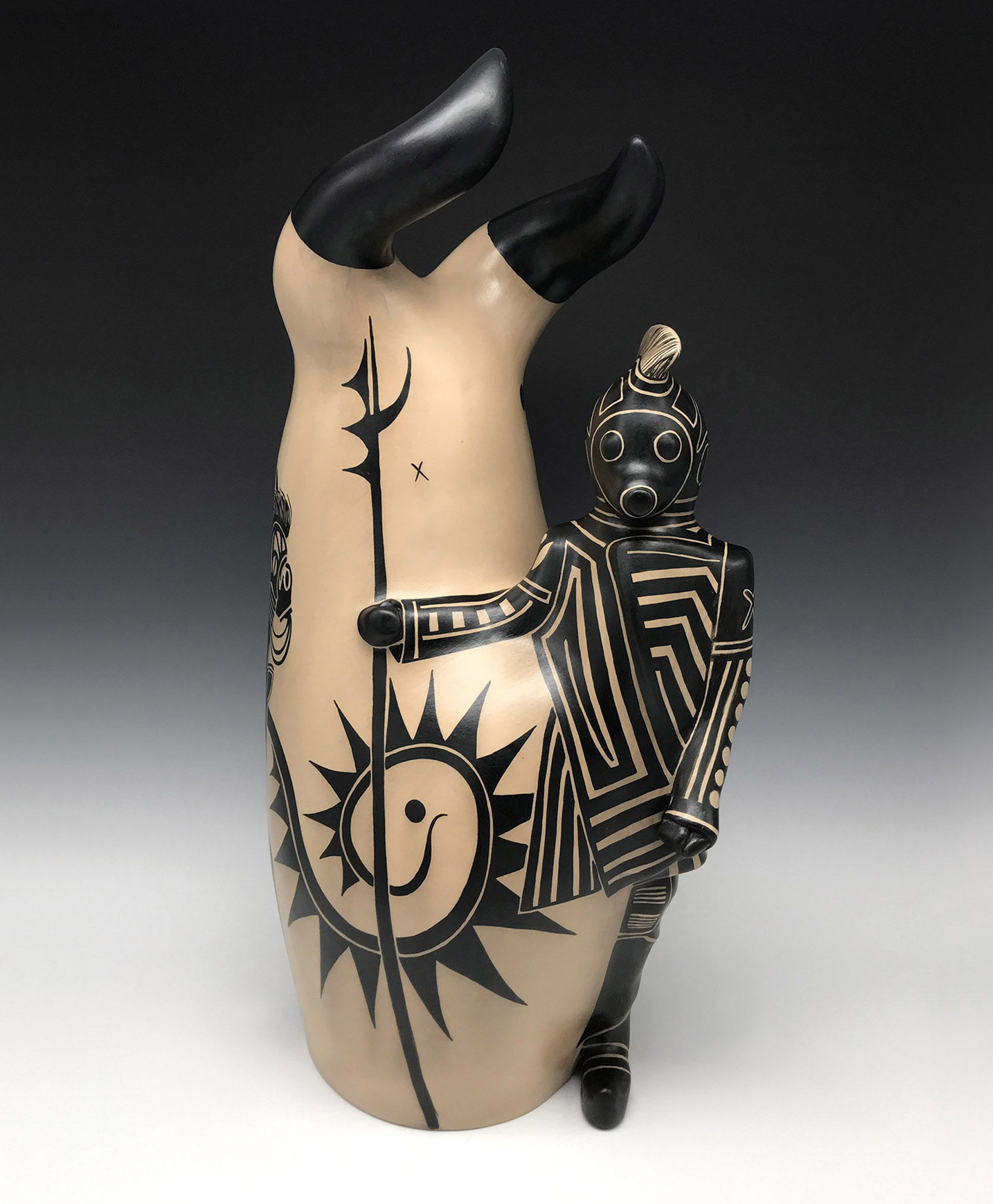 SP: This is a thing people were worried about, or had indeed experienced, bad results from having direct conversations. If you do question a policy directly, opportunities can be erased. You’re deemed a difficult person. How would you respond
SP: This is a thing people were worried about, or had indeed experienced, bad results from having direct conversations. If you do question a policy directly, opportunities can be erased. You’re deemed a difficult person. How would you respond
to people worried about getting shut out?
TA: You know, look, here's the thing – it's all about phrasing and it's all about tone. You've got to have your script. Don't get over anxious. You’ve got to be calm. You don’t need to raise your voice. You don’t need to sound accusatory. There are certain ways to ask questions, direct questions, and the right questions that you deserve an answer to. If a gallery just refuses or is playing difficult or is wishy-washy… oh, my God, get the heck out of there. That's a true telling sign that this alliance – you're not going to be in alignment with this entity. If somebody is resisting you, just get out of the way. You have to have faith that an even better opportunity, it's just right around the corner.
I don't like confrontation. I mean, I've had to deal with confrontation before, and I can get a little snappy and argumentative. It’s all in the phrasing and you can get a lot more with how you ask the question. The most important thing is to already have your script in order. Stick to the points – don't go there, don't go over there, stay right here. That's what I've learned and I encourage artists to practice the same, because you want results and honesty. You don't want some bullshit. You want to go into business partnerships or relationships believing that the person you're doing business with has good intentions, and that you guys are going to create something successful together.
SP: Virgil only works with one gallery now, right? How did you two make that decision?
TA: I have to be honest, inconsistent pricing was one. You go to one gallery and the work is a trillion dollars, and then over here, it would be a drastically different price point. That's not good. Right? That's not good at all. Also, Virgil has a great space, and we wanted to create an online presence as well. King Galleries has been in our orbit for a couple of decades now and it just works. Before COVID we would do theme shows with them. The relationship hasn't taken away from Virgil's opportunity to maximize selling directly to clients from his own website. We get those inquiries for art pretty regularly. The idea is to find strategically located galleries to work with – one on the East Coast, one on the West Coast, one in the… Find them and maintain your art. I always like to be exclusive, because I think that adds to value as well.
And I think the other part is – how do you get into those places? That’s a critical question, “I would love to be in XYZ museum. How in the heck am I going to get their attention?”
SP: Yes, in our conversations this summer one artist shared that he was finally invited to participate in an exhibition last year at a gallery he had been pursuing. For two years prior he had been sending regular updates, “Hi, here I am. This is what my work looks like. This is where I am at in my practice.” The updates were reported to be professional and persistent. What would you advise people to do to get the attention of a gallery or a museum?
TA: You know, I'd be curious to see what his pictures looked like. What did the portfolio presentation look like? I know, from experience that people at museums want to be wowed. They want to know, “Oh my gosh, we've got it! Get a look at this. Oh, my goodness, look at ALL this!” So I'm more curious, what was put in the pitch? How did he describe himself in his work? I think that's also critical. I hate it, but it's true. The presentation of your persona is critical and either you'll get people’s focused attention or you won't. Look at what COVID has done to the museums, they are closed, they have limited hours they are having to adapt. So, I think now my advice to artists is: step up your game. Make sure your package looks like a million dollars and start to communicate with these museums again. When the country re-opens it will be an opportune time.
SP: It does feel like we are in a time when you are going to have to evolve – galleries, artists, everyone – or you’re going to get left behind.
TA: Exactly, exactly. With V, he's doing some collaborations. He’s been stepping up creatively – always learning. He's like a sponge and he wants to do all these cool things. Every now and then we'll insert … like, next month we have an apparel collection that's going to come out called VO Voltage. It's super, super cool. We'll insert that while he's working on another collaboration of dinnerware. That is going to be exquisite. So, yes, evolution is key.
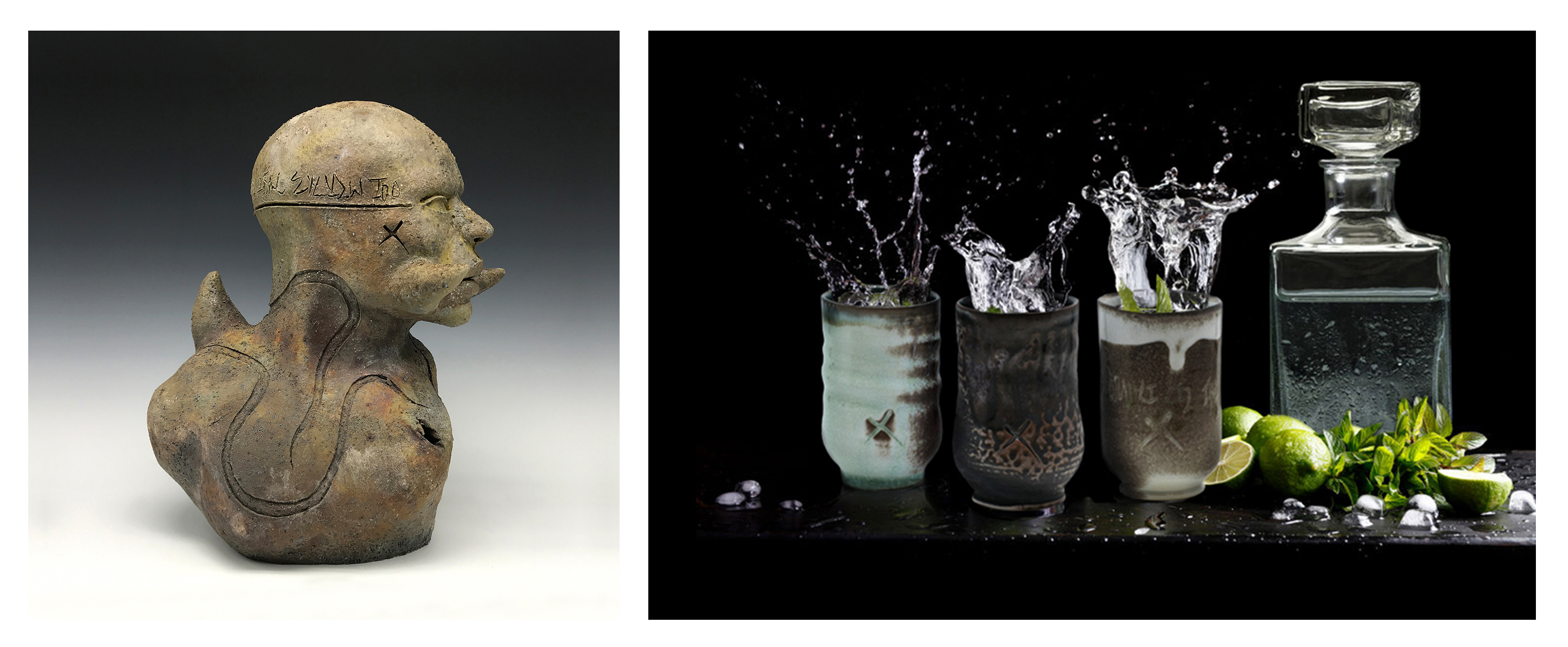
SP: We’re getting a clear idea that you operate from the position of “a good understanding makes a good agreement.” What do you think an artist should expect a gallery to do for them?
TA: I think being represented by a gallery could be beneficial to giving them additional exposure. I mean, these galleries already have their built-in clientele and collectors, and that's beneficial to an artist who's not been exposed to their particular marketplace, right? The other part of it is that some of these galleries are pretty savvy with their marketing. That can mean a gallery relationship is also an opportunity for the artist’s work to be featured in a magazine publication. Or the gallery could, by way of eblasts and newsletters to the gallery's clients, publicize the work, “Hey everyone, this month, we're featuring artists XYZ.” All these and other avenues can definitely benefit these artists working with the gallery – a reputable gallery, a gallery that has been in business, a successful gallery, a gallery that already knows their business model and how they market the artists they represent.
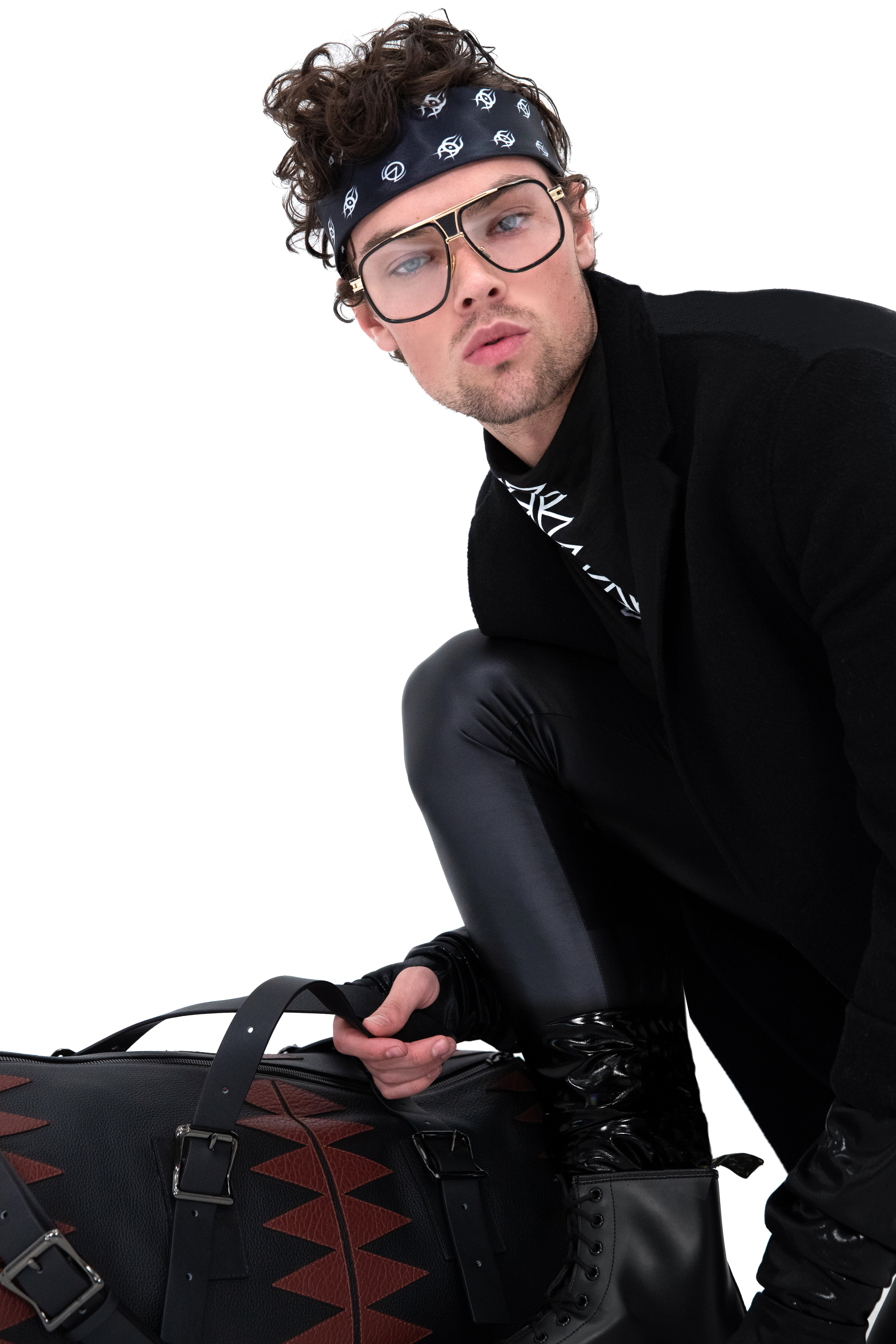 SP: The point was raised, when a gallery director talked about their connections as value added to the relationship, that some artists bring their own list of connections. They might have 20,000 people that follow them on Instagram. Sometimes these artists are invited to be in an exhibition because they're bringing their contacts with them. So the artists felt like, “I'm showing up to the table with my own clients. Who cares about your Rolodex?” I'm curious, what's your response to that?
SP: The point was raised, when a gallery director talked about their connections as value added to the relationship, that some artists bring their own list of connections. They might have 20,000 people that follow them on Instagram. Sometimes these artists are invited to be in an exhibition because they're bringing their contacts with them. So the artists felt like, “I'm showing up to the table with my own clients. Who cares about your Rolodex?” I'm curious, what's your response to that?
TA: I think, “Who are all these followers?” That’s the other critical question. If an artist has a lot of followers on Instagram, how many are actual customers? Do they just love the things that they see on the artists’ feeds? I think it’s a conversation that an artist and a gallery can have together. What is your sales turnaround on Instagram? What do you generate per month, per quarter, annually? If an artist is willing to share that information, that's great. It’s also an opportune time for the gallery to say, “Well, here, look, I've represented XYZ artists. This is what's happened with them. Their work has gone up this price point, and we see an alignment with your work, I can well see the same results happening.” I’m sure all of Virgil’s followers on Instagram are not purchasing his work. [10,000+ followers]
 SP: I take your point, but I also have to acknowledge that we're talking about drastically different price points. Most of the artists who were framing this argument are functional potters. Tish, they put up a show online, of their own accord, and it's sold out in an hour or less. When I see that, I think, “Okay, then maybe you don't need a gallery.” But it is a good distinction – are the people that are following you online buying? Another thing you said that I’d like to circle back to is the point that a gallery representing a small group of artists will be less likely to have the “dust collectors” getting forgotten in back stock. One such gallery told about how they push and push and push and push their artists. When they reach a saturation point and collectors are primed to buy, then the dealing can begin. For instance, if I'm a gallery and I'm selling a $10,000 work, I’ll have room to negotiate the price point within my fifty percent commission.
SP: I take your point, but I also have to acknowledge that we're talking about drastically different price points. Most of the artists who were framing this argument are functional potters. Tish, they put up a show online, of their own accord, and it's sold out in an hour or less. When I see that, I think, “Okay, then maybe you don't need a gallery.” But it is a good distinction – are the people that are following you online buying? Another thing you said that I’d like to circle back to is the point that a gallery representing a small group of artists will be less likely to have the “dust collectors” getting forgotten in back stock. One such gallery told about how they push and push and push and push their artists. When they reach a saturation point and collectors are primed to buy, then the dealing can begin. For instance, if I'm a gallery and I'm selling a $10,000 work, I’ll have room to negotiate the price point within my fifty percent commission.
TA: They want to have a collector's discount, a little ten or fifteen percent. If they're a VIP client and they spent a million dollars, I can see extending the discount to twenty percent. However, those decisions are made internally.
SP: Are you responsible for negotiations with Virgil’s work?
TA: Yes. Virgil does not do any of the negotiating, because that's not his job. We don't extend discounts unless a client will ask for it. Then I'll phrase my response in a particular way, “It's coming from Virgil, he would be happy to extend XYZ,” which makes it feel a bit more personal and special. Other than that, we don't negotiate. I was not popular, when I first started repping V. There were galleries that were wanting to consign Virgil's work, and we made the decision up front that we wouldn't consign. If you wanted to buy a piece of work the split was seventy-thirty.
I wasn't very popular, but I didn't want to win the popularity contest. I felt in the beginning that Virgil was – that [financial pressure] was just a little too much – he was just giving the house away. So, we don’t do consignment. It doesn't do us any good.
You can also get lost in galleries, take Santa Fe for example. You would get people trading between galleries and that just gets awful and tacky. You might have collectors that would buy a V piece and go to another gallery and trade it for something else. There's just too many hands. I think the work can kind of lose its value, its specialty and uniqueness. That’s what I was starting to see years ago. Since we just changed the way that we do business, it has not been an issue for us. Although I am first to say we don't work on a consignment basis, there will be times when I will make an exception. There haven't been many, but when I've made these exceptions, the results have been beneficial. I think you have to make decisions and play it out to see where you land.
SP: Tish, did you have a business mentor?
TA: I just learned being in the trenches of my corporate jobs. It’s the very reason I still get up at six in the morning. I've got work to do. I've got folks to speak to and I got stuff to make happen. No, I've not had a mentor, but you know, I had a solid family. My father Herman Agoyo, was actually the person that championed the initiative to have a statue of Po’pay installed in the National Statuary Hall in DC.[4] I have a good, solid foundation – a family foundation. I have siblings – one brother went to MIT, the other brother went to Stanford, one sister is the director of American Indian student services for the University of New Mexico. Let me tell you something, when I need something real quick, I have resources.
SP: Yes you do. Po’pay and the 1680 Pueblo Revolt is not just a passion for your family it is the mission underlining every decision you and Virgil make isn’t it?
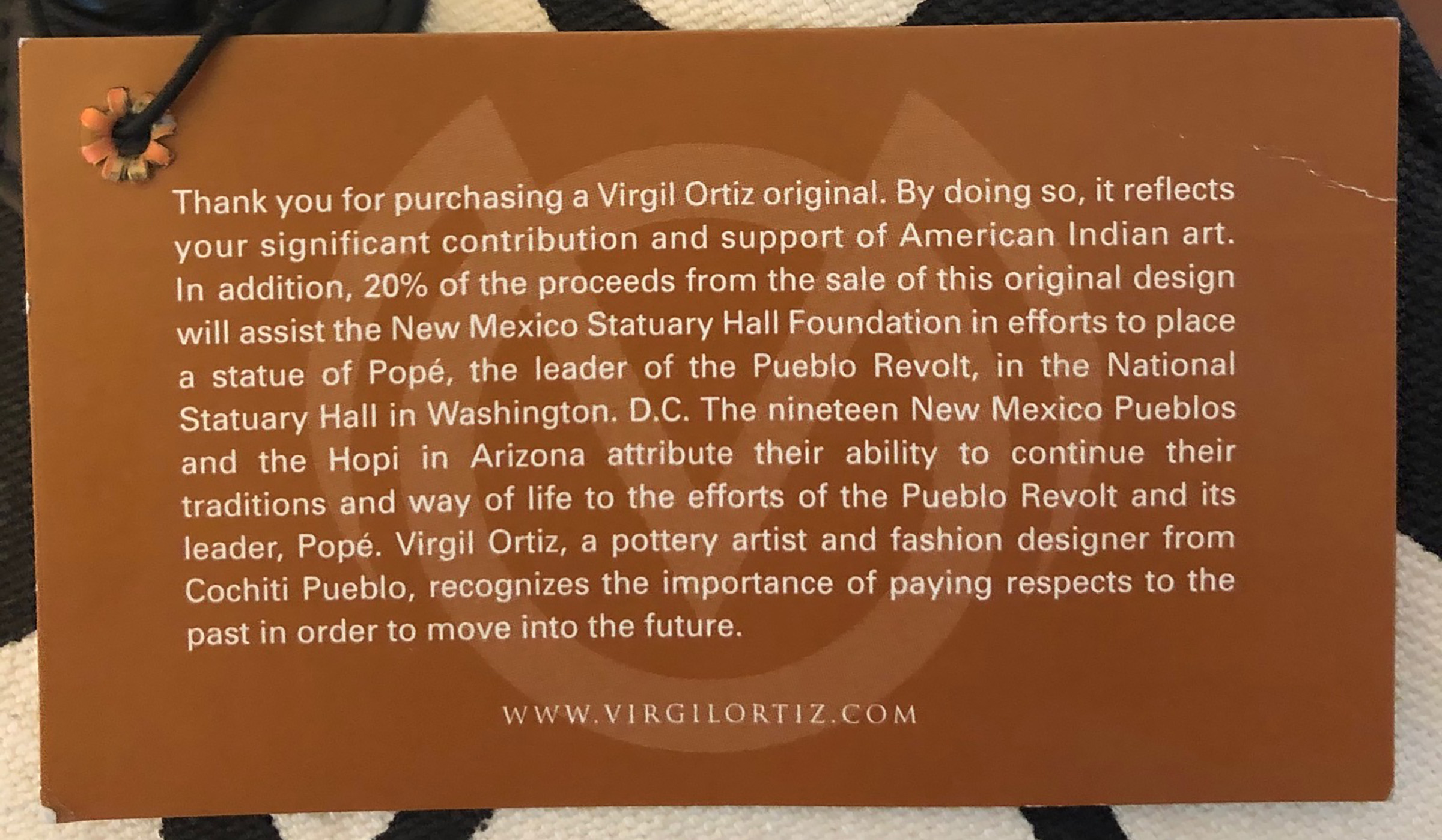
TA: Yes, telling the story of the Pueblo Revolt of 1680 is paramount. When V and I first got together in business I immediately hired a trademark attorney. The first thing I did was trademark his logo. [Pueblo culture is reflected in all VO designs, motivating this proprietary position.] Close to that time, we had just launched the purse design. My sister Pamela was the president of the Po’pay Foundation and they were about to take Po’Pay to Washington, DC. She said to me, “Tish, I think it's important that as you and V are starting your business together, that you consider donating a portion of the handbag sales to the foundation.” I said, “That's an excellent idea.” She pointed out that Dad worked all these years to get Po’pay to the capital, so that's how we marketed the purses. Coming out of the gate, we said, twenty-percent of the proceeds are going to the Po’pay Foundation. When they sold out in minutes, it was the greatest joy for me to write that check to the foundation. My dad died three years ago. One of his dying wishes – he said to me, “Tisha, I want you and Virgil to make sure that you continue to let people know what happened.”
And we do. We share what happened in 1680, history that was swept under the carpet. Like Virgil says, it was not taught in schools, nobody knows about the revolt, not even New Mexicans know that much about the revolt, but it happened, it was a real event that happened. And because Po’pay and all the Pueblo people rose up against the Spanish and threw them out for a brief twelve years we were able to preserve our culture, our language, and our traditions – because of Po’pay. And that's amazing.[5]
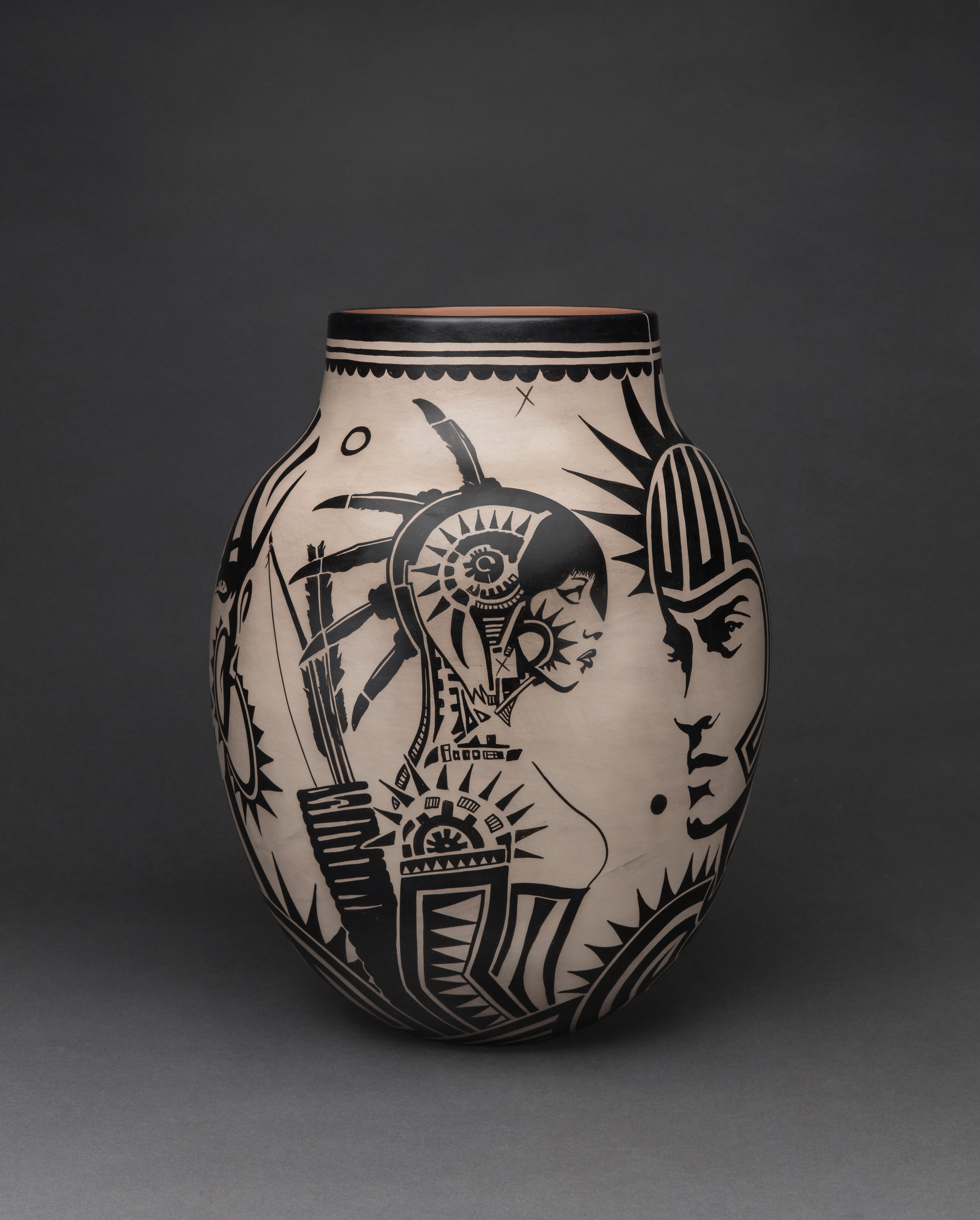 SP: Tish, thank you. It’s been illuminating to peek inside a dynamic partnership that operates from a deep motivation of heritage while adhering to hard business limits.
SP: Tish, thank you. It’s been illuminating to peek inside a dynamic partnership that operates from a deep motivation of heritage while adhering to hard business limits.
TA: You know, sometimes there are moments of silence on the phone. When neither Virgil or I are saying anything. Then one of us will say, “Okay.” We may go out together and talk. We may sleep on it. If we need to give it a little more thought, we can. That's how we navigate those hard-to-have conversations. I think it is because of Virgil's spirit – his spirituality and his whole being – he's taught me things about myself. I was much more rigid in the beginning. You couldn't bend me any which way. I want to say that I've become a little softer in my approach. You know, you get more bees with honey. I’ve become more open, more willing, and that is the key. You gotta just let things flow. You have to be mindful. You have to be cautious, but it doesn't always have to be a hard no. Virgil has taught me that. And I like it.
ENDNOTES
[1] Harris, R. Anthony. “Native American Futurist: The Work of Virgil Ortiz.” RVA, 2 Jan. 2018, pp. 22–27.
[2] To hear more about the Ortiz and Donna Karan collaboration and the evolution of his career, listen to Episode 155: VIRGIL ORTIZ ON REINTERPRETING THE PUEBLO REVOLT on Tales of the Red Clay Rambler. https://www.talesofaredclayrambler.com/episodes/virgil-ortiz-on-reinterpreting-the-pueblo-revolt
[3] Each August, the historic city of Santa Fe, NM becomes the Santa Fe Indian Market, enveloping the town’s central Plaza and surrounding streets. In addition, hundreds of gallery openings, art shows and related events take place during the weekend of Indian Market and during the two weeks immediately preceding it. Indian art collectors and artists from around the world make the pilgrimage to Santa Fe — whether they intend to buy or not. The Southwestern Association for Indian Arts (SWAIA) sponsors the event, which is estimated to bring more than 115,000 people and over $160 million in revenues to the state and region. https://market.swaia.org/history/
[4] Po’pay was among forty-seven other Pueblo men arrested in 1675 for the “alleged practice of sorcery,” writes Ohkay Owingeh Lt. Gov. Matthew Martinez on the New Mexico history website. After a trial, four of the men were sentenced to hanging, the rest were lashed and imprisoned. Po’pay later led the revolt against the Spanish colonial government in 1680. Indian Country Today. “Remembering Herman Agoyo: An Ohkay Owingeh Leader.” IndianCountryToday.com, Indian Country Today, 19 Apr. 2017, indiancountrytoday.com/archive/remembering-herman-agoyo-an-ohkay-owingeh-leader-Xislq8RrOUqJtVED3EQf5w.


